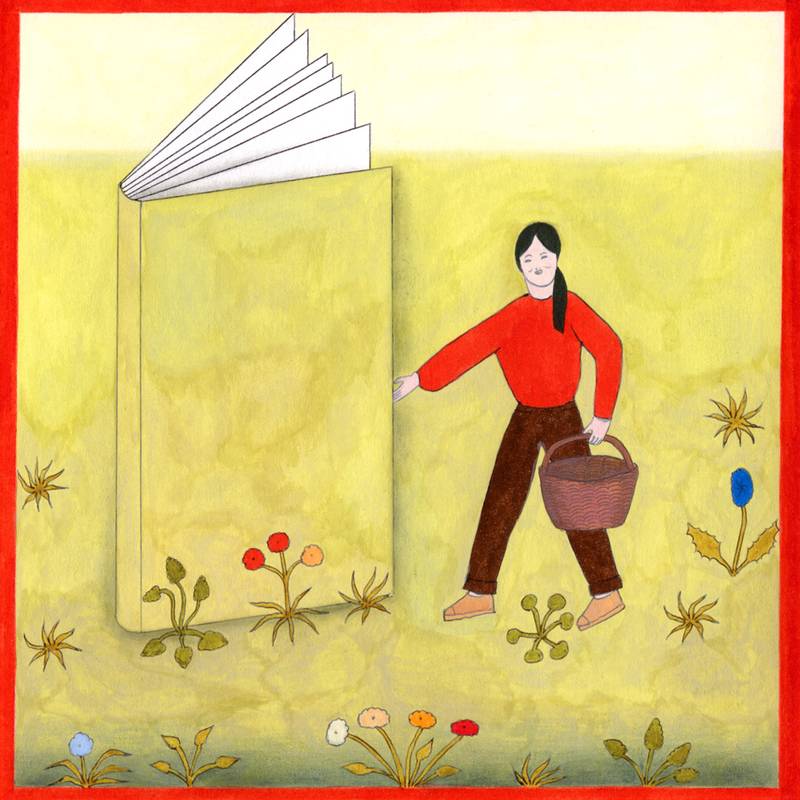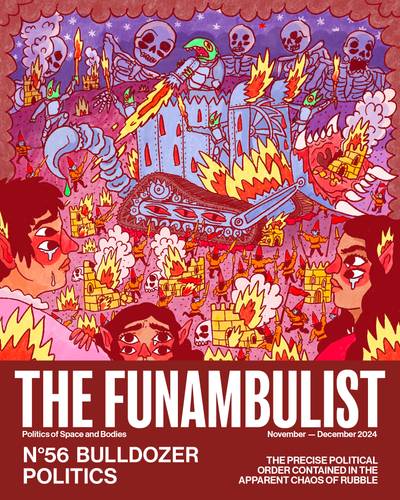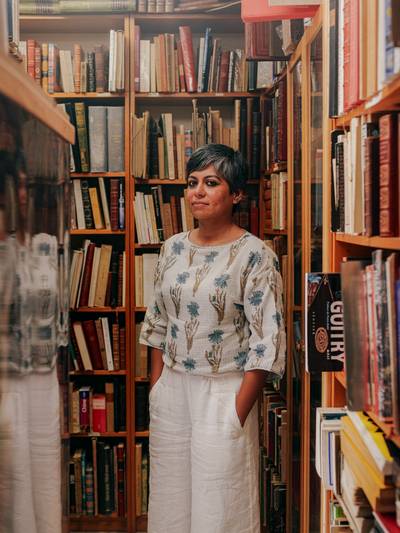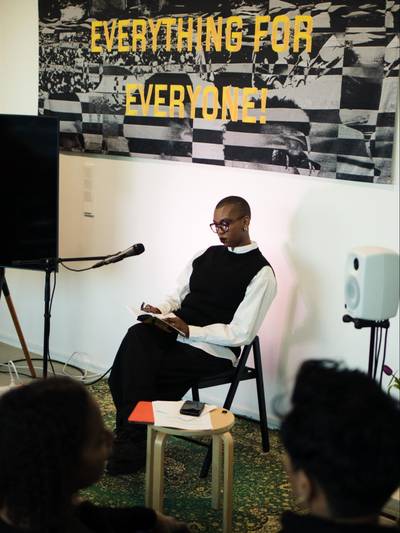

Portrait of Hikari Nishida by Chloé Bertron
Elliot Lundegård is a writer and an editor. They’re also a friend, a radical rester and a dreamer. They dream about companion species futures, ecologies, interconnectedness, healing justice and positive peace.
I’m meeting with Hikari Nishida on a late-April morning to talk about The Temporary Bookshelf (TTB), a non-profit space at Kaapelitehdas/Cable Factory in Helsinki where you can browse through and buy self-published and independent publishers’ books. Money from the sales goes directly to the authors through Mobile Pay or the Paypal contact of the author – the information for which is placed within the books. Hikari created TTB back in March 2021 and still runs it more than a year later – but, as you might guess from the word “temporary” in the name – that was not the plan when it all started.
This is not the first time I’m speaking with Hikari. Although we’ve mostly been in contact regarding TTB (since I’m the editor of Astra, a small feminist magazine they stock), we’ve also talked about housing in Helsinki. We were about to move into the same flat last fall. It feels like a typical example of how our work circles and private circles overlap and intersect, inevitably. This says something about money and politics, too: We both work in the field of art and printing, where we don’t make the kind of money needed to buy a flat in Helsinki. And we were both looking for a place to live with others, believing in communal and collective life. So, in a sliding doors moment, Hikari and I would’ve been flatmates. But we aren’t. And since our paths didn’t cross that time, I was happy to be invited to have this conversation with her.
We spoke about what TTB is, how it all started, and where it’s heading. As a fellow book-nerd, I also took the chance to dig deep into what a book is, how those at TTB differ from most in bigger bookstores, and what it means to be “a place for books as art practice”.
Not surprisingly, though, we also talked about money and community.
ELLIOT: I found it interesting that the first post on TTB’s Instagram page says that it’s focused on the book as an art practice. Does that imply that not all books are art or part of a practice of art? Why do you underline that the book can be an art practice?
HIKARI: People tend to have an exact idea about what a book is, and that idea is connected to the book business and industry. It’s the kind of book you can buy in any big bookstore. But that is not the book, it’s just one kind of book. And that kind of book is associated with a specific economy, which influences factors such as paper quality, the binding, et cetera. It’s a book shaped by the demand to run a business, to sell.
When I wrote out “books as art practice”, I intended to take some distance from that economy and give space to other definitions of the book. It opens up to questions such as ‘Ok, so what kind of format do I want for the reader? Do I want a book that is so big it’s hard actually to open it at all? What would that involve for the person holding it?’, and think about what kind of intimacy I want to convey by that. An example from TTB’s selection is Annaliisa Krage’s finestra aperta, a collection of six monochrome watercolour paintings printed on different cards wrapped together in a sheet of paper. Even though there is no binding, no cover, this is already a book, since it requires action that relates to the book: To open is to deploy the different cards like pages, looking at them one after another with a certain rhythm, succession, continuity.
Another example would be a zine from Sidonie Ronfard Pensées, a selection of photographs of personal events and encountered details. Printed, folded and “bound” (more like connected very loosely) by a thin fake gold chain that makes the zine look like a purse. The zine is presented in a thick plastic envelope. And there is a poem from Jacques Prevert slipped inside the zine too, handwritten (with spelling mistakes), on thick, purple paper.
This sounds like it is linked to the fact that TTB is a non-profit place, where all the money from the sold books goes back to the publisher. I haven’t been able to find any outspoken critique of the book industry on TTB’s pages – is it embedded between the lines?
[Laughs] Yeah, I think so! Of course, there’s a critique of the industry, and it’s trying to give space to the different definitions of what a book is.
What I like most about books is that they share a certain kind of intimacy with someone. You can give a book to someone, and they’ll have it in their home. And they’ll touch it! It’s a bit different from most other works of art. There’ll be a reader who’ll spend time with the book one-on-one. As an artist, this intimacy is what interests me.
Something I’ve discussed with other artists working with books is how the book is a medium that spontaneously connects you with others and encourages collaborative work. It’s really difficult to make everything in the process on your own, from content to the actual publishing and distribution of a book, which opens up the possibility for practices of being and working together.
It brings together different kinds of reception theory – one that concentrates on someone looking at or receiving an artwork and one concerned with the idea of a reader. If we imagine the kind of classical art that you’re supposed to interact with by just looking at it, how you interact with a book is very different, just as you said. You’re supposed to touch it, turn its pages, read its words or look at its illustrations. If we see the book as an artwork, it becomes an artwork that you interact with in a very intimate and physical way. And in a way, an artwork is recreated every time it meets a recipient.
Something I’ve discussed with other artists working with books is how the book is a medium that spontaneously connects you with others and encourages collaborative work. It’s really difficult to make everything in the process on your own, from content to the actual publishing and distribution of a book, which opens up the possibility for practices of being and working together. Another thing I like about books is how you can give a book to someone else when you’ve read it, you can pass it on as a present when you don’t need it anymore. It connects people.
When I prepared for this interview, I thought about how TTB feels like part of a community, and I was trying to pinpoint what conveyed that feeling. It doesn’t feel like a bookshop at all.
Being a platform for these specific publishing practices such as self publishing, independent publishers (often run by artists themselves), and artist books is at the core of TTB, so in a way, being a bookshop is the backbone of it all. But, the longer I continue with this project, I realise that the bookshop is not the most interesting part of TTB for me. Along the way, and as a natural continuity, the events around it started to feel like the more exciting part – because they create the opportunity to gather a community. The act of arranging something that hopefully is welcoming for all people who like books to come and meet each other.
The events have been really popular, so I’ve concentrated more on that lately. The dream is to have a kind of book space that could gather different events and have that at its centre. I want people who aren’t already part of the community to feel welcome, even people who might think it’s weird or nerdy, to hang around art books!
Gathering around books sounds like my dream too! The question about how to make something feel welcoming and open to everyone is the core of many discussions – and still, it’s an issue, right? I think about that a lot in my work with Astra: How do I make the journal feel welcoming? The mix of wanting to be nerdy, wanting to have these kinds of special interests, doing alternative things, and at the same time being welcoming, not only speaking to other nerds.
I try to work in a way where the events can be very open, and it’s okay if you just attend because there’s an opening and there are drinks! Maybe you get more interested in the books when you’re there. That’s perhaps my tactic… Strategy!
And of course, you want to be nerdy because you’re so into it, and you want to dig deep into something, be cryptic… [Laughs] And, people could be interested even if they don’t get it. But then the nerdiness probably works as a shield. It’s a delicate balance, you have to do both, be nerdy and be welcoming.
“As a recent example of such an attempt, I organised on May 14-15 the first edition of the Under the Leaf book fair. I arranged it together with Sara Blosseville, one of two people behind the zine publishing house Fétiche based in the woods of Vantaa, and Monitoimitila O, an artist-run space in Helsinki, hosted the fair.”
At a time when most artists and independent publishers post on social media about their books and you can DM them directly if you want to buy anything, I think a place that is a physical hub has a special value. You can check out many things you otherwise wouldn’t have known about. You don’t necessarily “have to know” whom to follow on Instagram.
One impression I get of TTB and what you’re saying about events is the weight you put into it being a real space. Was that part of your original intention?
I started TTB at Kosminen after Khaos Publishing, run by Iina Esko, closed their bookshop in the space in spring 2021. As someone who makes books as an artist and loves art books, I was sad that the space for books would disappear. There aren’t many places in Helsinki that focus on self-published or independent publishers’ books. So the first thought was just to continue that kind of platform.
At a time when most artists and independent publishers post on social media about their books and you can DM them directly if you want to buy anything, I think a place that is a physical hub has a special value. You can check out many things you otherwise wouldn’t have known about. You don’t necessarily “have to know” whom to follow on Instagram.
That connects to what you said about being a welcoming space. A real space that people pass by or walk through or can see from the street doesn’t demand that people have to know who to follow on social media. And now you have recently moved TTB to Kaapelitehdas!
The new space in Kaapeli is an artistic megastructure with different studios and museums. TTB is located in the café area, where there’s an upper floor where you can sit and work. It’s cosy. I remember the manager emphasising that you don’t have to buy anything in the café, you can just bring your laptop and sit there. They’re trying to see it as a public space.
I’ve seen some people act a little shy but still check out the books – it’s lovely to witness that. But I need to say that I have observed that people who buy books from TTB more or less know about the project. And they know TTB is here, and they come with a purpose.
What are your thoughts on gathering different books in the same space? Because all of these small independent publications … Something happens with them when they’re all standing side by side. How do you choose which books to stock?
I started with books I knew about from independent publishers in Finland and France, where I studied at the Livre [book] department at La Haute Ecole des Arts du Rhin. I was excited to bring things from France as well. I enjoyed those weird aesthetic things that they’ve got going on. For example, the artist collective At The Same Time’s zine titled Veuillez Patientez is a riso printed poster wrapped by itself like an envelope. The content and cover are the same, plus it includes a flexi disc. Another example is illustrator Chloé Bertron’s self-published zine. And I was hoping that by bringing them to Finland, I could add something new to the field here. So I had the idea of making these things meet. But nowadays people are often coming with their works to me.
You have created a hub, then!
In a way, yes – every week, someone asks if they can have their book at TTB. I then ask them to send me some pictures and a short text describing what the book is about.
So you’re curating the space, and what’s in there?
Yes, although I haven’t said no that many times. Of course, I have my own taste, but I like to keep it quite broad. As long as they’re self-published and not problematic, and don’t convey hate speech or racism, I feel it’s nice that these books have a place to be.
On the one hand, the grant system is great because if you have a grant, you can make all these projects happen, which is different from how it works in many other countries – France, for example. But on the other hand, it creates a landscape where things grow a bit like mushrooms. They pop up and then suddenly disappear.
It sounds like you’re being very generous with the space.
It is partly because I don’t pay rent for TTB to be in Kaapeli. So that’s very kind and generous from their side as well. Since it’s free, there’s no pressure at the moment.
The limitation has more to do with how much time I can put into this project myself. I have to say that lately, it’s been quite a lot. I started naively on my own, thinking, “this is gonna only be for three months”, [laughing] “then it’s going to be over, that’s why it’s called The Temporary Bookshelf”. Then it got extended – first for six months, then until the closing of gallery Kosminen, and now it’s at Kaapeli until March 2022 with the possibility of extension.
I’m thinking a lot about how and what to make of it in the long run. So far, it’s mostly exciting, but I can already see that it’s quite a lot to do alone. I’m working with TTB almost every day, but I’m not paid for it at the moment like I was last year when I had working grants. Except, of course, when I prepare or curate books for external events! For example, I’ve been part of The Month of Books at PUBLICS and was invited to talk about publishing practices at a webinar arranged by Hippolyte. Those have been paid jobs and have functioned as an extension of the original work with TTB, which I’m very happy for. It’s like bringing a “temporary bookshelf” to others’ events!
How to make artistic projects work in the long run is something that many people have written about – working with grants, working with limited resources, working with having to make projects very temporary because you have a temporary grant.
On the one hand, the grant system is great because if you have a grant, you can make all these projects happen, which is different from how it works in many other countries – France, for example. But on the other hand, it creates a landscape where things grow a bit like mushrooms. They pop up and then suddenly disappear. It would be nice if this project could continue, but if I don’t have the money, it becomes tough to do so independently. So I’ve currently been thinking about structuring it more sustainably.
So despite TTB being so much of a community thing, in the end, it’s just you – one person – behind it. And even if it creates space for community, it’s also a lot of work on your shoulders.
I’m trying to think about how to involve more people in the actual work on the practicalities. I think it could be a lot of fun to do it as a group and come up with great ideas together that I wouldn’t have had on my own. It’s lovely to bounce back and discuss with other people in the field.
Linking back to the dream you mentioned earlier, to have a space that is maybe a bookshop, perhaps just a small space for book launches – can you see yourself doing that?
Totally! It would be great to run it the way you run your own space. But now, the work with TTB sounds like a central part of my life – I’m also doing other practices of my own. So it’s a fine balance. If I’d run my own book space, it would be open like two days a week, maybe? I don’t see myself being a bookshop keeper.
Do you feel like you run TTB more as a fellow artist, or what is your role?
I would like to see it that way. Not that I have any problem with bookshop keepers! But I would love to have this space for book launches, book fairs, exhibitions around publishing practices, workshops (perhaps zine-making or printing technique workshops such as risography), possibilities that would make people meet, share, experiment – for book possibilities to happen.
They just opened a new independent bookshop right where I live in Stockholm, but they are connected to a small publishing house. I think it’s the second or third small bookshop that has opened here, and it’s interesting to see how they work and manage to survive. This new bookshop has events twice a week; often, they invite authors to talk about their books. But there’s an important difference between what you’re doing – offering a space, not selling things on commission, organising community events, and doing it as a fellow artist – and putting up a store centred around selling and the book economy in another way. As you said in the beginning, “the book as an art practice.”
Exactly! This project aims to give visibility and a platform to certain books, let them be seen, be more known as a practice, be read, and be bought. In that order, I’d say. So the point is not to be sales-driven. The book business is very complex, too. I’ve been thinking that maybe I could take some commissions to be more independent from applying for grants in the future.
But then I stop and think: Am I just going towards this boring kind of “business”? Is it a trap? There’s so much liberty at the moment. That’s something I appreciate. But how do I continue? I haven’t solved that yet, but I’d love to. In a way, it’s fine if it’s not me who runs it, it could even change its name from TTB to something else. Whatever! I just want there to be a space for specific books. And space to make new events and continue experimenting with books – around what they are and what they can be.







